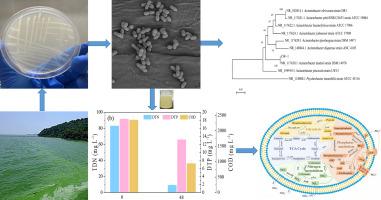An acid- and low-temperature-tolerant heterotrophic nitrification-aerobic denitrification strain for soybean processing wastewater treatment
IF 6.7
2区 工程技术
Q1 ENGINEERING, CHEMICAL
引用次数: 0
Abstract
A heterotrophic nitrification-aerobic denitrification (HN-AD) strain, Acinetobacter tandoii CW-1, was isolated from the Microcystis-attached microbiota in Lake Taihu. This strain demonstrated exceptional nitrogen removal capacities, achieving peak removal rates of 3.9 mg N L−1 h−1 for ammonium (NH4+), 5.8 mg N L−1 h−1 for nitrate (NO3−), and 2.5 mg N L−1 h−1 for nitrite (NO2−). During operational optimization, strain CW-1 demonstrated efficient utilization of the organic carbon present in soybean processing wastewater (SW) under slightly acidic condition (pH 5.26). Notably, it maintained an ammonia removal efficiency of 48.5 % after 48 h of cultivation at 10 °C, indicating its functionality at low temperatures. Under the optimized conditions, 99.4 % of the NH4+ in the SW was removed within 48 h. Concurrently, 60.0 % of the Chemical Oxygen Demand and 28.0 % of the dissolved total phosphorus were also eliminated. Whole-genome sequencing revealed a multifunctional N-removal system in which NH4+ is eliminated via assimilation while NO3− is removed through assimilatory nitrate reduction to ammonia. To our knowledge, this study represents the first successful utilization of an HN-AD strain for the treatment of SW, demonstrating the considerable potential of strain CW-1 in this field.

一株耐酸耐低温异养硝化-好氧反硝化菌株处理大豆加工废水
摘要从太湖微囊藻附着菌群中分离到一株异养硝化-好氧反硝化(HN-AD)不动杆菌——檀香不动杆菌CW-1。该菌株表现出优异的脱氮能力,对铵(NH4+)的峰值去除率为3.9 mg N L−1 h−1,对硝酸盐(NO3−)的峰值去除率为5.8 mg N L−1 h−1,对亚硝酸盐(NO2−)的峰值去除率为2.5 mg N L−1 h−1。在操作优化过程中,菌株CW-1在微酸性条件下(pH 5.26)对大豆加工废水(SW)中的有机碳进行了高效利用。值得注意的是,在10℃培养48 h后,其氨氮去除率仍保持在48.5%,说明其具有低温功能。优化后的工艺条件下,48 h内SW中NH4+去除率达99.4%,化学需氧量和溶解总磷去除率分别为60.0%和28.0%。全基因组测序揭示了一个多功能n -去除系统,其中NH4+通过同化消除,NO3 -通过同化硝酸还原为氨去除。据我们所知,这项研究是首次成功利用HN-AD菌株治疗SW,表明菌株CW-1在该领域具有相当大的潜力。
本文章由计算机程序翻译,如有差异,请以英文原文为准。
求助全文
约1分钟内获得全文
求助全文
来源期刊

Journal of water process engineering
Biochemistry, Genetics and Molecular Biology-Biotechnology
CiteScore
10.70
自引率
8.60%
发文量
846
审稿时长
24 days
期刊介绍:
The Journal of Water Process Engineering aims to publish refereed, high-quality research papers with significant novelty and impact in all areas of the engineering of water and wastewater processing . Papers on advanced and novel treatment processes and technologies are particularly welcome. The Journal considers papers in areas such as nanotechnology and biotechnology applications in water, novel oxidation and separation processes, membrane processes (except those for desalination) , catalytic processes for the removal of water contaminants, sustainable processes, water reuse and recycling, water use and wastewater minimization, integrated/hybrid technology, process modeling of water treatment and novel treatment processes. Submissions on the subject of adsorbents, including standard measurements of adsorption kinetics and equilibrium will only be considered if there is a genuine case for novelty and contribution, for example highly novel, sustainable adsorbents and their use: papers on activated carbon-type materials derived from natural matter, or surfactant-modified clays and related minerals, would not fulfil this criterion. The Journal particularly welcomes contributions involving environmentally, economically and socially sustainable technology for water treatment, including those which are energy-efficient, with minimal or no chemical consumption, and capable of water recycling and reuse that minimizes the direct disposal of wastewater to the aquatic environment. Papers that describe novel ideas for solving issues related to water quality and availability are also welcome, as are those that show the transfer of techniques from other disciplines. The Journal will consider papers dealing with processes for various water matrices including drinking water (except desalination), domestic, urban and industrial wastewaters, in addition to their residues. It is expected that the journal will be of particular relevance to chemical and process engineers working in the field. The Journal welcomes Full Text papers, Short Communications, State-of-the-Art Reviews and Letters to Editors and Case Studies
 求助内容:
求助内容: 应助结果提醒方式:
应助结果提醒方式:


